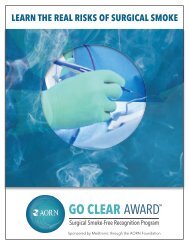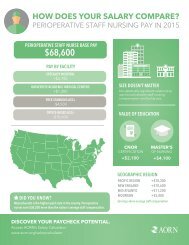AORN Go Clear Award™ Brochure
The AORN Go Clear Award™ is a comprehensive approach to ensure a smoke-free environment wherever surgical smoke is generated to protect patient and worker safety. The award recognizes health care facilities committed to a surgical smoke-free environment for their perioperative team and patients.
The AORN Go Clear Award™ is a comprehensive approach to ensure a smoke-free environment wherever surgical smoke is generated to protect patient and worker safety. The award recognizes health care facilities committed to a surgical smoke-free environment for their perioperative team and patients.
Create successful ePaper yourself
Turn your PDF publications into a flip-book with our unique Google optimized e-Paper software.
The chemical, biological, and physical components of surgical<br />
smoke pose a health risk to the exposed perioperative team and<br />
patients. Eliminating surgical smoke from your OR will improve<br />
patient and worker safety and allow you to recruit and retain top<br />
employees. Do you know the hidden dangers of surgical smoke?<br />
= 5,000<br />
healthcare<br />
workers<br />
There are an estimated 500,000 healthcare workers who are exposed to laser or electrosurgical smoke each year 1<br />
More than<br />
150<br />
ALL 16 U.S. EPA PRIORITY<br />
POLLUTANT PAHS<br />
(polycyclic aromatic hydrocarbons)<br />
have been detected in surgical smoke 3<br />
hazardous<br />
chemicals<br />
have been<br />
identified<br />
in surgical<br />
smoke 2<br />
1 Laser/Electrosurgery Plume. Occupational Safety and Health Administration (OSHA) Quick Takes. United States Department of Labor http://www.osha.gov/SLTC/laserelectrosurgeryplume/index.html (accessed February 19, 2016).<br />
2 Pierce JS, Lacey SE, Lippert JF, Lopez R, Franke JE. Laser-generated air contaminants from medical laser applications: a state-of-the-science review of exposure characterization, health effects, and control. Journal of Occupational &<br />
Environmental Hygiene. 2011;8(7): 447-466<br />
3<br />
Naslund Andreasson S, Mahteme H, Sahlberg B, Anundi H. Polycyclic aromatic hydrocarbons in electrocautery smoke during peritonectomy procedures.. Journal Of Environmental & Public Health. 2012;2012: 929053.





